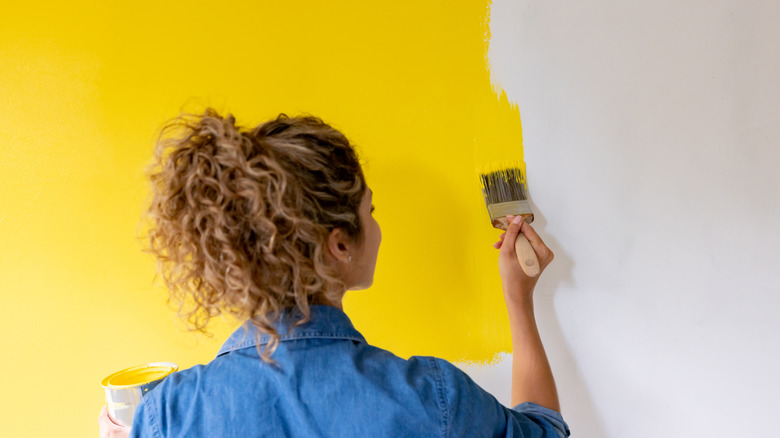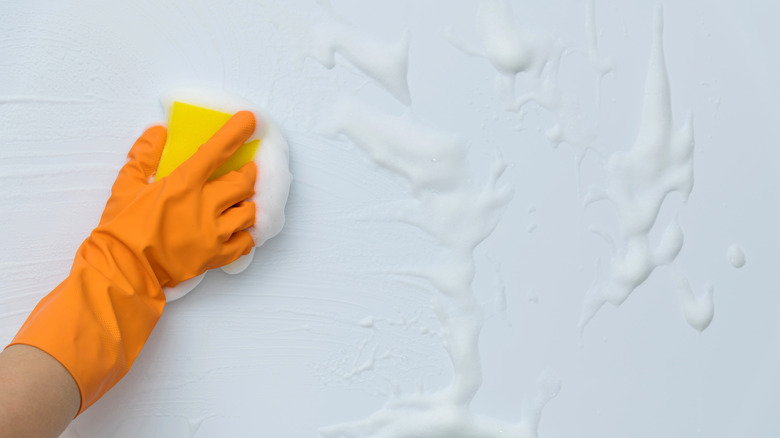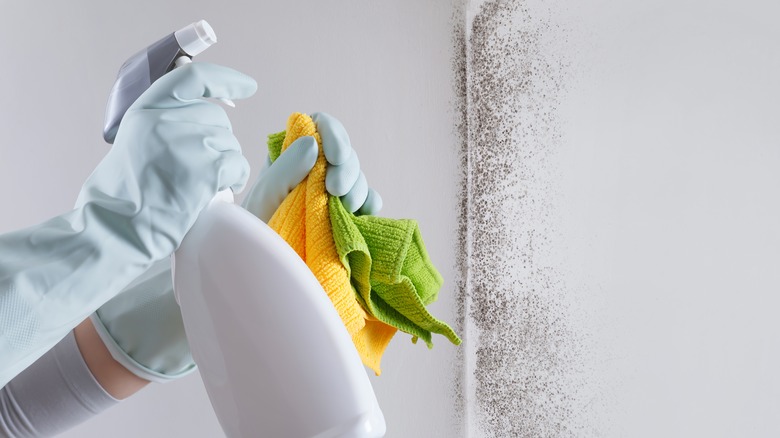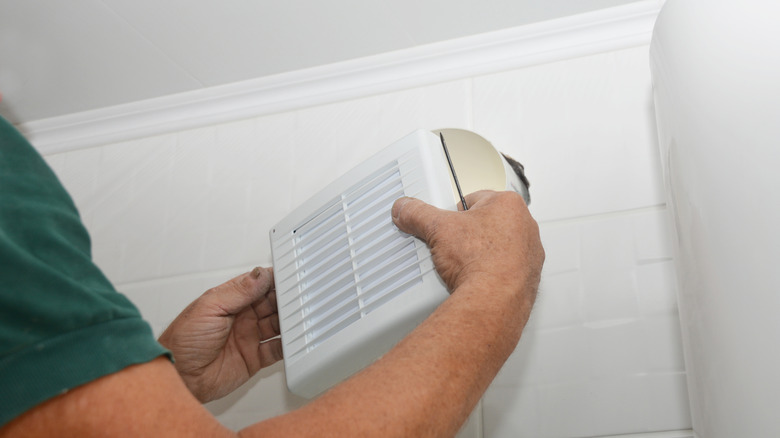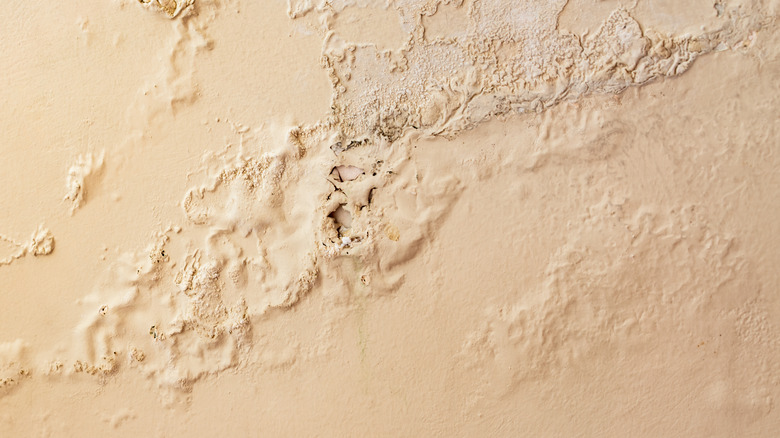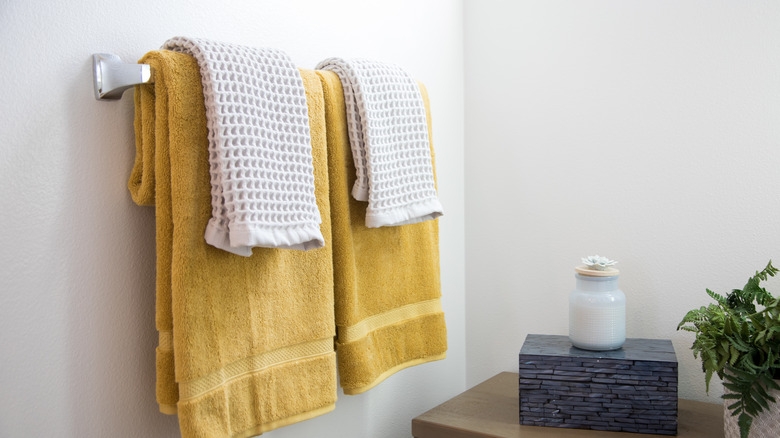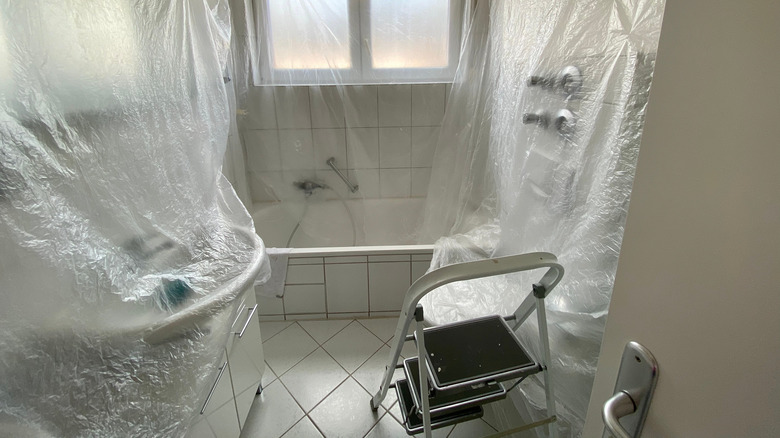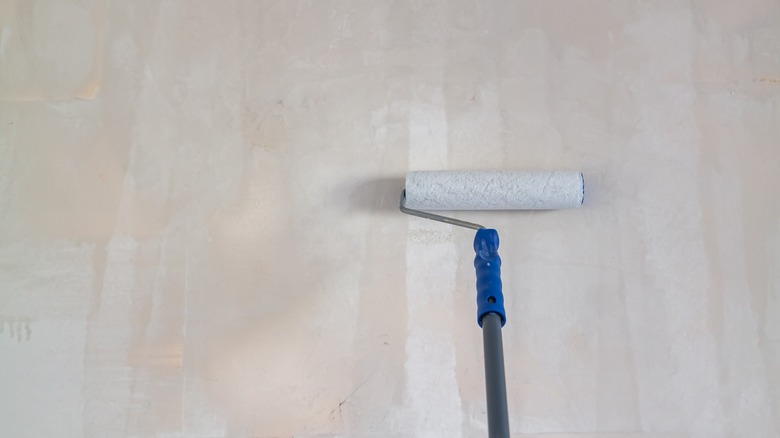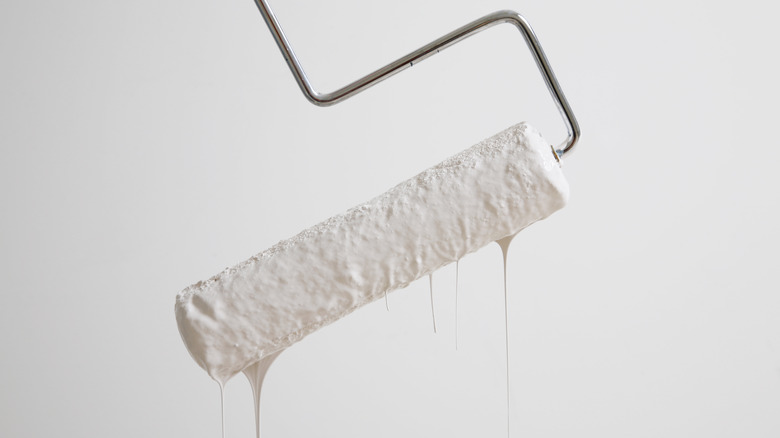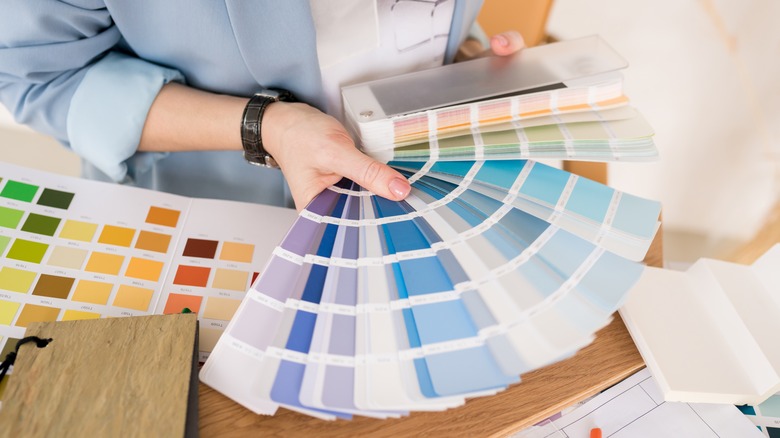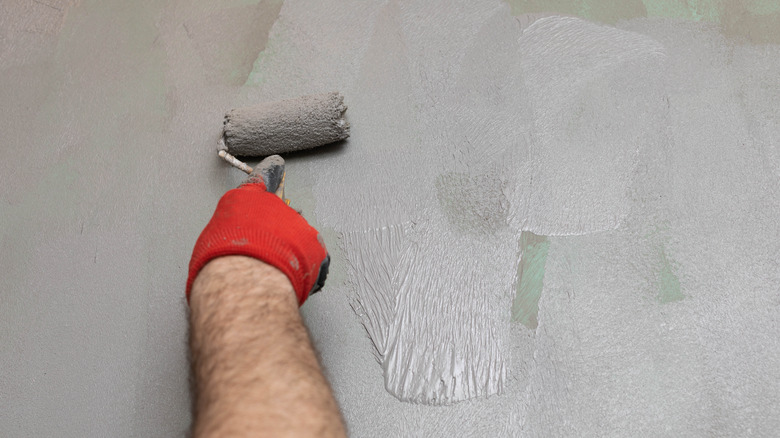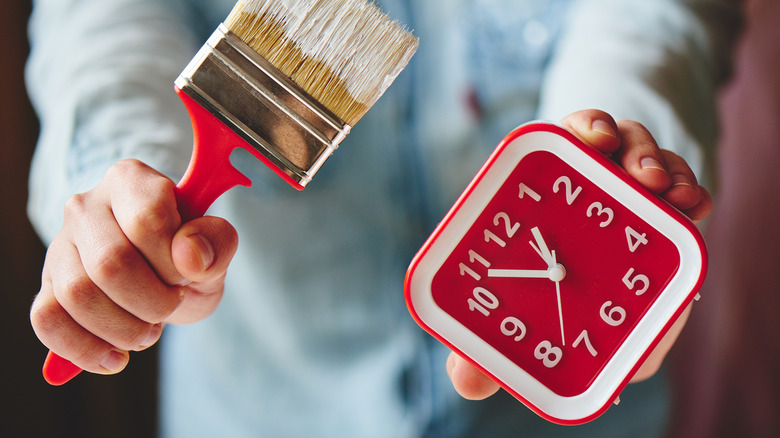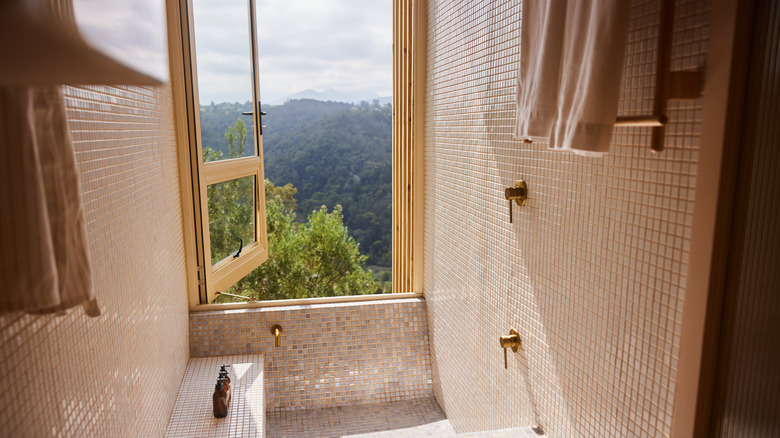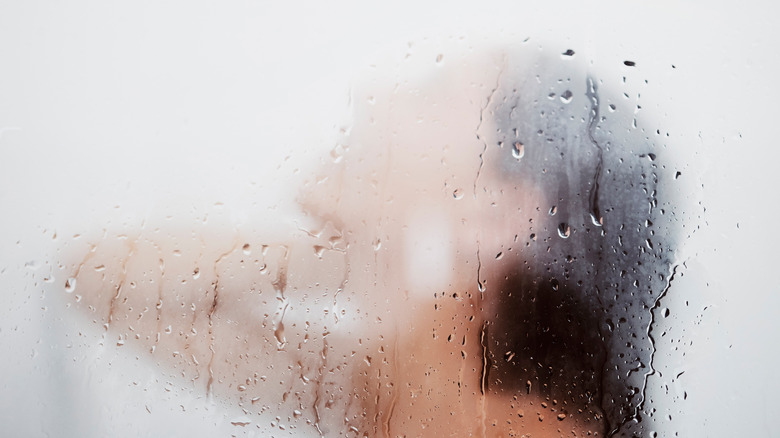Avoid These Common Mistakes When Painting Your Bathroom
We may receive a commission on purchases made from links.
Repainting a bathroom is a cheap and simple project that can freshen up your space within a few days. For less than a hundred bucks, you can transform your bathroom from dingy to design-worthy. But although it is a relatively straightforward DIY job, this doesn't mean you can slap some paint on the walls and call it a day. For pro-level, long-lasting results, you need to invest time into prepping the space, money into the right paint, and thought into the color scheme.
If you don't, disaster can strike in the form of bubbling paint, mold growth, and more. Bathrooms are, by nature, damp, humid environments. Thanks to this, it's one of the rooms in the home where you really need to adhere to painting best practices and not cut corners. So before you crack open that can of paint, keep reading for some of the most common mistakes you can avoid during this home project.
Not scrubbing your bathroom walls
The first step to a stellar paint job in any space is cleaning the walls, but it's especially important in the W.C. There are a couple of reasons for this. If you apply things like hair spray, other styling products, and aerosol deodorants in the bathroom, this can leave an invisible slick of residue on the surfaces over time. Bathroom walls can also accumulate grease and grime from soap scum, detergent particles in steam, and even (shudder) dead skin cells. The average person sheds roughly 600,000 skin cells per day, which makes up about 70% to nearly 90% of the dust in our homes and on our walls.
Grease and waxy residues can make it hard for paint to strongly adhere to your walls. You might not notice any immediate problems, but over time, your new paint job may be more prone to peeling and flaking. To avoid this, thoroughly scrub down your bathroom walls with a degreasing agent such as TSP (Trisodium Phosphate). TSP is the gold standard cleaning agent to use before painting, and it can cut through grease, smoke residue, and other nasties like a ninja. Don't have any TSP but want to get started on your project? You can also use diluted soap in a pinch, especially if your bathroom walls aren't too dirty.
Not addressing existing mold issues
Are you planning to paint your bathroom because there's mold popping up? If the answer is yes, you need to first address the mold and then move on to painting. Try to see if you can spot any underlying causes that are triggering it. If mold is growing in response to a leaking pipe in the wall, painting over the patch is only going to cover up the problem. In a few months, the mold will most likely break through the paint again. Besides checking for leaks, take a look at your extractor fan. Is it big enough for the space?
Once you've rectified any issues that might be the root cause of the mold, figure out a game plan for removing it. If the infestation is really bad, you may want to call in a team of mold removal pros. For less serious mold growth, such as a couple of patches on the ceiling, you might be able to kill it off with an antifungal sterilization product specifically meant for mold, such as Concrobium Mold Control. You can also use bleach diluted with water in a 1:5 ratio. Make sure you wear a mask while tackling mold, as the spores can cause respiratory issues.
Not drying out your bathroom if it has a damp problem
Excess moisture levels can impede proper paint drying and adhesion. For a primary bathroom that sees daily use and a lot of steam, you might want to give it a day or so to dry out before applying your first coat. If this sounds like an inconvenience and you can't afford to not use the shower or tub prior to painting, a dehumidifier can speed up the drying process. Failing that, make sure the windows are open, the door is flung wide, and the fan is on for a few hours after the last shower.
If your primary bath isn't very damp, has great ventilation, or a high-powered extractor fan, you probably won't have to dry out the space for multiple days. The same applies to powder baths that don't see a lot of steam or have any damp issues.
Not scraping off loose, bubbling, or flaking paint
If you paint over loose, flaking, or bubbling paint, your job is a) going to look shoddy and b) not last. Bathrooms can be prone to peeling paint, as they're one of the dampest areas of the home. If there are any places where the paint is coming loose, this is one of the first prep tasks to tackle. Start by using a scraper to remove all loose paint. If the bubbling is bad, try tapping around to see if there are any hidden air pockets or loose areas that aren't visible yet.
Once you've scraped away any paint that isn't properly adhered, you may be left with some irregularities. Painting over these dips won't hide them. To get your walls back to their former smoothness, you can fill in the uneven areas with joint compound. Begin by sanding down the edges of the existing paint. Spread a thin layer of drywall compound, let it harden, and sand it smooth. For a perfect finish, you might need to repeat the process once or twice.
While you're at it, check the rest of the bathroom for places that could be sealed or caulked. For example, have your baseboards or crown molding pulled away from the drywall? This is a great chance to fill those gaps.
Not removing the towel bars and door handles
Another common mistake to avoid is failing to remove your towel bars and any other fittings that you can easily unscrew. If you leave things like door handles, toilet roll holders, and outlet covers, they may get in the way of your painting. You might also get paint on those fittings, and you'll probably be able to see the brush and roller marks where you struggled to get around them. Nothing screams "DIY job" more than obvious brush lines.
Unscrew all fittings that are simple to take down. Make sure you tape the screws onto them so none get lost during the project. While you're at it, you can tape off the things you don't want to take down, like light fittings or toilet edges. While it will be harder to paint around these bulky things, they may be difficult to put back onto the wall once disassembled, so it might be best to leave them.
Choosing a cheap paint that's not designed to handle high moisture levels
One of the most important mistakes to avoid when painting a bathroom is buying any old can of latex or acrylic. You need to get quality paint that's designed to withstand humidity and high moisture levels and that will prevent mold and mildew growth. Many people assume that the best type of paint for a bathroom is always something with a high gloss. While glossy paints can be easier to clean, paint technology has come a long way. Nowadays, you can buy bathroom paints that will withstand mold and moisture in matte and eggshell finishes. If you have your heart set on a low-luster look, options like Benjamin Moore's AURA Bath and Spa will give you a soft finish while still being resilient enough to handle the moisture-laden conditions of a bathroom.
What if you've spotted the perfect hue for your bathroom, but it's not formulated for moisture or mildew? In this case, you have a couple of options. You can go for a glossy finish that will be easier to clean and less permeable, or use an anti-mold additive, such as Microban. Just make sure you're still opting for a high-quality paint. Premium paints are pricier, but cheaper versions typically have poor coverage and require extra coats, which means you'll use more.
Not protecting your tile grout with drop cloths
You're a neat worker — you're not going kick over a can of paint. If you do spill, you'll wipe it up immediately. You don't really need a drop cloth, right? Wrong! Not laying down drop sheets is a signature newbie painting mistake, and it's one that you'll especially want to avoid in the bathroom. It's always important to use drop clothes to catch drips and the fine spray that comes off rollers. In tiled areas like the bathroom, the key thing to protect is your grout. Paint splatters on tiles aren't too hard to clean off. But grout is porous, and any paint you spill can leave permanent marks.
To prevent this, make sure you not only lay drop cloths on the floor but also protect areas like the shower and tub surrounds. You can do this by taping up plastic sheets and tying plastic bags around your taps, faucets, and other features. Take a moment to also tape off the edges of tiles. Finally, to avoid getting paint on the potty, cover that too.
Assuming you don't need to apply primer
If your bathroom is in relatively good shape — without peeling paint — and you're just giving it a quick refresh, you probably don't need to use a primer. But if you're dealing with mold or moisture-damaged paint, you may need to prime the affected areas before you can move on to applying your top coat. Mold can eat away at paint, leaving plaster or bits of bare drywall exposed. Make sure you first do a coat of primer on any surface that's not covered with wall paint, including raw drywall, plaster, plywood, cement, and places where you used joint compound. If there are any large marks or stains, you can also apply primer to these areas. Dark marks can often shine through light paint, even after multiple coats. Going in with primer first will help to hide them and cut down on the number of topcoats you'll need.
There is one situation where you may need to prime the entire bathroom. If the original paint is oil-based and you're covering it with latex or acrylic, you'll want a layer of oil-based primer in between to create a solid bond. Because mold can so easily take hold in bathrooms, look for an antifungal primer like Kilz Mold & Mildew Primer for your project.
Being heavy-handed with your first coat
If you're itching to cover up that old paint, it can be tempting to apply a nice thick layer for your initial coat. Unfortunately, more isn't better when it comes to paint layer thickness. The more paint you apply in one go, the longer it will take to dry. Most paints require extended drying times in moist environments like bathrooms. There's no need to add extra hours onto this with coats that are too thick. Applying overly thick coats can also cause your paint to run, which is never a good look. This will create drips, and it can take a whole lot of sanding to get rid of them.
To avoid all this, start by lightly dipping your roller into the paint on your tray. Don't dunk it in, or you'll get too much on the roller. Don't overfill the tray either; only the well should have paint in it. The ramp-shaped part is there for you to disperse the paint you picked up from the well area by rolling it back and forth. For even yet thin coverage, don't start too close to the corners. Otherwise, you run the risk of pushing excess paint into areas where you've already got cut lines. Once you've rolled a wall, go back over it without putting more paint on your roller. This is known as back rolling, and it helps to even out the coverage while still maintaining a thin coat.
Not weighing your options when it comes to color
Before you bust out your roller, you should also give thought to the color scheme of your bathroom. As you can see, painting a bathroom can be a multi-day project, and now is your chance to make a smart color selection. The first thing to consider is whether you want to "wrap" your bathroom by applying the same color to the walls and the ceiling. This can give a very cohesive, immersive feeling, especially if you're going with a darker hue.
You can also choose to paint the ceiling a different color than your walls. Neither of these approaches is right or wrong; it just depends on what effect you want. For instance, if you have medium-toned walls, a white ceiling could help to give it a crisp finish and add lightness and brightness to the space. If you're going for a moody, enveloping feeling, then wrapping the whole room in one color could be ideal.
Speaking of moody, a lot of people make the mistake of feeling like they have to stick to safe colors like white, beige, or gray in the bathroom. If very neutral tones will work best in your space, that's great. But don't automatically assume that bolder choices will look terrible. Have a browse around places like Pinterest to gather paint color ideas and see if there's anything that might make your bathroom pop.
Applying too few coats
Skipping that second coat can speed up a painting job, but a practiced eye will always be able to see that you cut corners. You'll end up with patchy results instead of a seamless finish. Too few coats can also allow for mold regrowth.
It can be tempting to stop at the first coat and throw in your brush, but if the walls are still looking even slightly patchy, it's wise to do one more. Two coats are usually enough for minor color changes, but if your bathroom is in bad shape, or you're painting over a very dark color, you may need to do three. Also, keep in mind that the number of coats you should do can also depend on the paint you buy. As outlined above, cheap paint tends to have poor coverage. If you grab a budget bucket of paint, you may have to go back over your walls twice as often as you would with a high-quality product from a brand like BEHR or Sherwin-Williams.
Not allowing enough drying time
Rushing and not giving your paint enough time to dry between coats can cause it to peel, bubble, leach surfactants (which look like dark beads of waxy sweat), and crack once cured. This is because you're essentially trapping excess moisture within the paint by not allowing it to evaporate out between coats. This can be especially problematic in bathroom areas, which are prone to moisture issues as it is. Most paints require longer drying times in humid conditions. Low temperatures can also slow things down. Getting paint to dry in a bathroom in the middle of Arizona is probably not going to be a problem. A damp bathroom with poor airflow in Florida? You may have to wait twice as long to apply another coat.
Here are some general drying time guidelines. Water-based wall paint will usually become touch-dry within 30 minutes to an hour. But just because the paint feels dry doesn't mean you can proceed with the next coat. You should wait at least two hours before doing a second coat with acrylic paint in the bathroom, four to five hours for latex, and a full day for oil. Primer also requires at least four hours of drying time.
Not ventilating the space
Another common mistake that you'll want to avoid in the bathroom is forgetting about ventilation. Good airflow can help paint dry faster, and it's also very important if you're using oil-based coatings or any type of tile paint. Enamel and two-component paints can give off high amounts of VOCs, which can be a health hazard. Water-based paints such as latex and acrylic emit much less of these gases. Be sure to follow the safety guidelines on the box and wear a mask to protect yourself from the fumes.
Even if you choose a water-based paint containing low levels of VOCs, having good airflow while you're painting is still important. Besides being better for air quality, the more ventilation there is, the quicker you'll be able to get going with your next coat. If you aren't able to fling open a window or crank an extractor, you can also look into running a dehumidifier in the space or setting up portable fans to get a breeze going.
Using the shower right away
The final mistake to avoid after repainting your bathroom is using the shower or tub too soon. If you apply thin enough coats and ventilate your space, your final coat should be touch-dry within an hour or so. But this doesn't mean you can celebrate with a hot shower!
After you have applied the last coat, your paint job will need to cure. Water-based paint can take anywhere from two weeks to a month to fully harden and dry out. During this time, it will be softer and scratch more easily, so it's generally recommended not to clean the painted surfaces or push furniture against them. Fortunately, you can shower during this time, but you do need to wait at least 48 hours. If you can wait longer than this to use the tub or shower, even better. If your bathroom doesn't have great ventilation and the temps are low or the air is very humid, you may want to wait even longer. If you do have to use your shower shortly after repainting, try to use warm water instead of hot so there's less steam and ventilate the area afterward.
